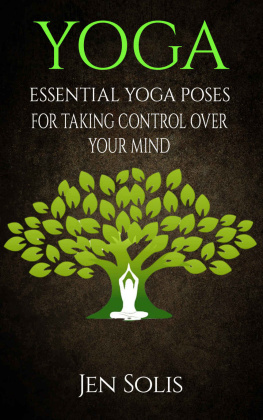Yoga :
Essential Yoga Poses for Taking Control Over Your Mind
Copyright 2015
All rights Reserved. No part of this book may be reproduced in any form without permission in writing from the author. Reviewers may quote brief passages in reviews.
Disclaimer
No part of this publication may be reproduced or transmitted in any form or by any means, mechanical or electronic, including photocopying or recording, or by any information storage and retrieval system, or transmitted by email without permission in writing from the publisher.
While all attempts have been made to verify the information provided in this publication, neither the author nor the publisher assumes any responsibility for errors, omissions or contrary interpretations of the subject matter herein.
This book is for entertainment purposes only. The views expressed are those of the author alone, and should not be taken as expert instruction or commands. The reader is responsible for his or her own actions.
Adherence to all applicable laws and regulations, including international, federal, state and local laws governing professional licensing, business practices, advertising and all other aspects of doing business in the US, Canada, UK or any other jurisdiction is the sole responsibility of the purchaser or reader.
Neither the author nor the publisher assumes any responsibility or liability whatsoever on the behalf of the purchaser or reader of these materials. Any perceived slight of any individual or organization is purely unintentional.
Table of Contents
Introduction
Yoga has a long and rich history that, like many things, has been developed and refined over time. The goal of this book is to accomplish a few things as you read. First, I want to give you some history on the practices of yoga and how they were developed. Its always interesting to know the origins of something, as it can broaden your mind. As such, I intend to provide some background on the original purpose of yoga. With this knowledge, you will hopefully be able to dive in to this book with more of an open mind.
The whole idea of this book is to give you poses or exercises that will help you gain control of your mind and be able to focus your thoughts, which can be a very powerful tool. Which brings us to our next goal, teaching you about breathing and the power that can bring. The idea of yoga is to reach enlightenment, to this end, if you can control your breathing you will be on your way to controlling your body, which in turn gives you control over your mind. The whole idea of yoga is to put your body through various positions of increasing difficulty, and the more control you have over your mind the easier it will be to accomplish the more difficult poses.
Which brings us to the next goal, and for most people the meat of any yoga book. The poses or positions that are meant to help you focus the mind. Yoga practice typically starts with the more basic ones, just trying to meditate and relax the mind and body and gradually moving toward more difficult positions while hopefully still being able to maintain the relaxed state of body and mind.
Control over your mind is so important for yoga and for everyday life. When you have the power to focus, your mind can exert some form of control over a muscle that truly seems to have a mind of its own. Through yoga practice, you will be able to have better focus and hopefully achieve happiness. This happiness comes from enlightenment, the discovery of your body and the ability to focus and sharpen your mind. We will discuss how this control is important to yoga and can translate into other aspects of your life in the last section of this book.
Yoga is learned, something that can be taught and something that can be very beneficial to those of you who may feel troubled or unfocused in their life. Once you have started down the path to yoga, I hope this book will be a book you can use to help you along the way. I also hope if you love it you will continue on your journey and try to learn as much as you can to benefit you and help you achieve your goals of enlightenment and control over the mind.
Chapter 1: A Brief History
Yoga has long been thought of as an exercise meant to help increase flexibility and strength through mastering different postures. But yoga has always had another purpose. It was originally focused on applying and understanding the world as a whole, but its focus changed over time to the self, believing that self-enlightenment was the ultimate goal. It was believed a person could bring about a profound transformation in themselves by sacrificing ego through self-knowledge, action, and wisdom. This idea of sacrificing the ego came from the ideas of the ritual sacrifice that the Upanishads performed in order to transform into what they believed to be a better and harder sacrifice, one of the self. Sacrificing ones ego can be a difficult path, but this journey to spiritual discipline was believed to give one greater control over their mind and body and lead them to a healthier, happier version of themselves.
The exact history of yoga can be a little hazy, as much documentation has been destroyed with time. What we do know is that yoga originated in the East. There has been evidence of yoga postures found on artifacts traced back to ancient Shamanism dating to around 3000 BC. Evidence of yoga was discovered in the oldest known existing text, the Rig-Veda. The Rig-Veda is a collection of hymns with topics covering prayer, harmony and greater being.
It actually wasn't until the sixth century BC that meditation and the poses were implemented into yoga. The Buddhists started teaching them and they became a critical element to focusing the mind and disciplining the body. For historical purposes, yoga can be split into four separate periods.
Pre-Classical Yoga was considered the start of yoga, developed in Northern India well over 5,000 years ago. The first mentions of yoga are in the texts of the Rig-Veda mentioned earlier. This collection was used by Brahmans or the Vedic priests, much like a modern Christian priest would use the bible. During this time, yoga was refined and eventually developed by Brahmans and mystic seers who documented everything about their practices and beliefs in these Upanishads, which is a huge collection of works giving home to over 200 scriptures. The most well known of the yoga scriptures was also created in this period, about 500 BCE, the Bhagavad-Gita. Yoga is a broad term, as there are actually many different teachings of yoga. When the Upanishads changed the idea from ritual sacrifice and turned it to self sacrifice, or sacrificing something like the ego, it was done through first getting to know the self, then action (which was karma yoga), and finally, wisdom (which was jnana yoga). Yoga, like many things, has become a board term that many people don't realize has so many different facets to its history and practices.
The next period, Classical Yoga, becomes a more focused period for this developing belief system. In Pre-Classical Yoga there was a large variety of information presented with many various beliefs, techniques and ideas on the subject with many conflicting and contradicting one another. In this period, a step-by-step presentation of yoga was developed by Patanjali, presented in his Yoga-Sutras. His text was believed to be written during the second century, and explains the path of Classical Yoga, sometimes obscurely known as Raja Yoga. Patanjali organized yoga in a path with 8 different limbs, sometimes depicted in statues in India. This system contained everything you would need to obtain enlightenment, which is also referred to as Samadhi. Many see Patanjali as the fore-father of yoga and his system still strongly influences many styles seen in modern yoga.
Like many human beings, yoga went through an almost rebellious sort of stage where the original teachings were rejected and masters of their discipline sought to stretch the boundaries and try to make new discoveries and techniques. This was the Post-Classical Yoga stage and was developed a few hundred years after Patanjali. These yoga masters developed a system believed to prolong life and revitalize the body. They rejected the ancient teachings such as those in the Vedas and believed that they could embrace their physical bodies as a means to achieving enlightenment. Tantra yoga was developed in this period; it was a combination of techniques believed to cleanse all. The thought was you should break the binds that connect us to our physical selves in order to achieve enlightenment. It was these teachings and explorations that brought up to the creation of Hatha Yoga also known as Yoga of the West.
Next page






